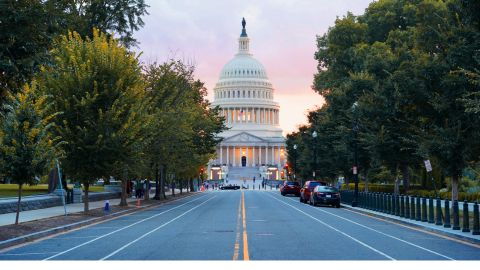What does Biden’s budget mean for science?
President Joe Biden’s 2023 budget request last month proposed significant funding increases for the agencies that support scientific research and development, but even if Congress appropriated every last dime that the president requested it still wouldn’t be enough to meet the pressing needs of the nation.
The president requested $49 billion for the National Institutes of Health base budget (a nearly 10% increase), $10.5 billion for the National Science Foundation (a 19% increase) and $7.8 billion for the Department of Energy Office of Science (a 4.5% increase).
The appropriations process spans several months. First, the Office of Management and Budget gives guidance to federal agencies about funding levels and priorities and then makes final decisions about the agencies’ proposed budgets. From there, the president creates the administration’s budget request and submits it to Congress.
Then, the House and the Senate develop their own budget resolutions and set spending levels, which often deviate from one another and from the president’s request. Lastly, the House and the Senate negotiate their differences and ultimately pass a reconciled appropriations bill in both chambers, which the president signs into law.

NIH needs more funds to support its core functions
At its core, the NIH is focused on funding investigator-initiated research. Its 27 institutes and centers support more than 60,000 projects and 300,000 investigators on average each year.
Biden’s proposed 10% funding boost would continue the trend of increasing the budget of the NIH. In FY22, NIH was appropriated $45 billion, up from $43 billion in FY21, translating to roughly a 3% increase.
While a 10% increase for FY23 is better than the budget being stagnant, it’s important to keep in mind that consumer prices rose 7.5% between January 2021 and January 2022 and $5 billion of the $49 billion is specifically directed to the Advanced Research Projects Agency for Health, which would be focused on cutting-edge treatments and therapies for high-burden diseases. The budgets for most of NIH’s institutes and centers would remain flat.
A $300 million increase to the NIH’s base budget is not enough to meet the needs of the scientific community. After all, the spending power of a NIH R01 grant is not what it used to be: A $250,000 grant has only 55.5% of the value it had in 2001, according to the Biomedical Research and Development Price Index. (See chart.)

Scientists doing important research need more from federal funding agencies, especially considering their foundational work has directly led to the development of a vaccine for the SARS-CoV-2 virus.
Biden recognizes that NSF needs more funds
In March, the NSF established a new Directorate for Technology, Innovation and Partnerships, which aims to fund research that could lead to breakthrough technologies and move discoveries more quickly into the marketplace.
NSF Director Sethuraman Panchanathan proposed an initial budget of $865 million, but Congress’ omnibus bill in March failed to fund the new directorate and increased the NSF’s budget by only 4%, bringing it to $8.8 billion. This limits the directorate’s ability to start new activities this fiscal year, which runs through September.
It’s vital that Congress robustly fund the NSF for FY23, and Biden’s budget proposal reflects that: The administration is proposing $10.5 billion for NSF, which would strengthen the agency’s leadership in emerging technologies.
Importantly, Biden’s proposal also includes 16% more for NSF’s educational and workforce training program, including boosting the number of graduate research fellowships from 2,000 to 2,500. Robustly funding STEM workforce development is necessary to ensure the American research enterprise’s scientific productivity.
DOE’s Office of Science sees biggest proposed increase
The Biden administration proposed a 4.5% overall increase in funding for the DOE Office of Science, which would be spread across five major research programs. However, in the president’s budget request, the biological and environmental research program would receive the largest increase, a 10.9% increase to $904 million in FY23. If Congress can agree on this boost, it would be a significant win for the scientific community.
Many organizations are advocating for changes to the numbers presented in Biden’s budget — especially the budget proposed for the NIH.
On March 30, the Ad Hoc Group for Medical Research called for $49 billion for NIH’s base budget (instead of the $45 billion proposed by Biden), saying: “We are concerned that the bold proposal for the nascent Advanced Research Projects Agency for Health comes at the expense of NIH’s annual base budget, which ultimately would undermine the success of both entities ... (T)he coalition urges lawmakers to ensure no less than $49 billion for NIH’s base program level and that any additional funds for ARPA-H supplement, rather than supplant, this core investment in NIH.”
The National Coalition for Science Funding is asking for at least $11 billion for FY23: “We ask Congress to make bold investments in the NSF this year, setting the agency on a course to advance domestic innovation and to keep pace with investments other countries are making in research and development."
Read the full ASBMB statement here.
Enjoy reading ASBMB Today?
Become a member to receive the print edition four times a year and the digital edition monthly.
Learn moreGet the latest from ASBMB Today
Enter your email address, and we’ll send you a weekly email with recent articles, interviews and more.
Latest in Policy
Policy highlights or most popular articles

Councilors advocate for science on Capitol Hill
ASBMB Councilors meet with their elected officials to advocate for basic scientific research funding and training the next generation of scientists.

Hope for a cure hangs on research
Amid drastic proposed cuts to biomedical research, rare disease families like Hailey Adkisson’s fight for survival and hope. Without funding, science can’t “catch up” to help the patients who need it most.

Supporting science through advocacy and community building
ASBMB calls on scientists to take action as funding cuts and policy shifts threaten the U.S. research enterprise, emphasizing the power of community advocacy and persistence in protecting the future of science.

Seven steps to advocating in your home state
Find out how to schedule, prepare for and conduct a productive district office meeting to communicate the importance of fundamental scientific research funding to your representatives.

ASBMB members call for funding and agency support amidst uncertainty
In 60 meetings on Capitol Hill, scientists urge legislators to reaffirm support for scientific innovation

Embrace your neurodivergence and flourish in college
This guide offers practical advice on setting yourself up for success — learn how to leverage campus resources, work with professors and embrace your strengths.

